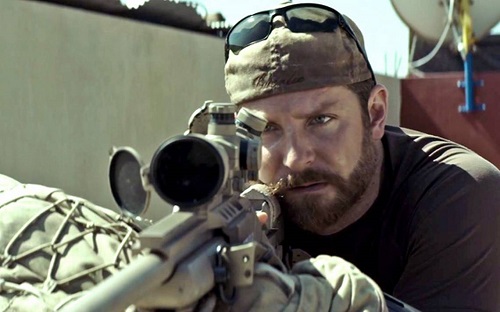
The Remasculinization of the New American War Film
Written by Thomas Ærvold Bjerre, Associate Professor at Department for the Study of Culture
Clint Eastwood’s American Sniper, which opened in the US in December 2014, is a milestone film in several respects. Not only is it the highest-grossing Eastwood film of all time. It also became the highest-grossing film of 2014 in North America. Even, it became the year’s second-biggest money maker, eclipsed only by Michael Bay’s Transformers: Age of Extinction. And of special interest to this blog, it became the highest-grossing war film of all time, breaking the record held by Saving Private Ryan. In this respect American Sniper marks a culmination of American Iraq war films. In fact, the one thing that the US films about the war on terror have had in common is that they have failed to make money in the US. The Hurt Locker, which won six Academy Awards, including Best Picture, is the least-grossing Best Picture film of all time, grossing just over $17 million in the US.
American Sniper’s $350 million US gross should also be seen as a result of a change in the ideology of the American war films. The nature of these films has changed from complex interrogations of the fragmented and multi-perspectival nature of truth (Redacted, Battle for Haditha that failed miserably at the US box office) over narratives whose complexity was entrenched in a recognizable heroic frame (The Hurt Locker, Green Zone that still failed at the US box office) to the trend that Eastwood’s film has solidified and that moviegoers have embraced: overt male heroic narratives that point back to the propaganda films of World War II. This new cycle of war films was initiated with Act of Valor, and continued with Lone Survivor and American Sniper.

Clint Eastwood’s American Sniper is a milestone film in several respects.
The Movie opened in the US in December 2014
Photo: Print screen from the film.
Like most of the new Iraq war films, American Sniper is rooted in authentic experience; in this case Chris Kyle’s now contested memoir. Yet the claim to authenticity is glossed over by traits that clearly adhere to propaganda, such as “exaggeration of ideas already present in a given culture” as well as extraction and elevation of “selected themes to become the norm” (Culbert xv). What Eastwood—and Kyle’s memoir—exaggerate and elevate is especially the notion of “soldierly masculinity,” defined by Jon Robert Adams as “the particular brand of traditional male function associated with heroism—courage, suppressed emotion, strength, and clearheaded decisiveness” (9). Despite an attempt to nuance its protagonist through a focus on PTSD, both film and book fall back on a regressive view of masculinity—a rugged frontier machismo that in itself invites an unintended reading of the Iraq War as a continuation of American imperialism.
It also suggests yet another post-war attempt at a remasculinization of America, like the one Susan Jeffords examined in the wake of Vietnam, where the Rambo and Missing in Action films offered an escapist fantasy of victorious American manhood far from the disillusionment found in earlier Vietnam films like Apocalypse Now and The Deer Hunter. The remasculinization that plays out in Act of Valor, Lone Survivor, and American Sniper suggests an urgent need to “escape” and “domesticate” the ways in which the War on Terror has stripped bare the instability of our everyday life (to paraphrase Slavoj Žižek’s discussion of symptoms).
And the need for escaping or domesticating seems even more potent when it comes to the next big production about America’s war on terror, Michael Bay’s 13 Hours: The Secret Soldiers of Benghazi, which opens in the US on January 15. Based on the 2011 attack on the US Embassy in Libya by Islamic jihadists, the trailer and the tagline “When everything went wrong, six men had the courage to do what was right” promise yet another fantasy of soldierly masculinity. Add to this Michael Bay’s trademark style of pompous, slick, and action-filled frames that leave no room for substance, and it would seem that the filmic representation of war regressed back to a crude state that mirrors the shrill patriotism that drowned any reasonable debate in the aftermath of 9/11. It seems that, at least for now, we have to look elsewhere for a nuanced and complex interrogation of a conflict that has come to define the new millennium.
Notes
Culbert, David, ed. Film and Propaganda in America, Vol. 3: World War II. Westport, CT: Greenwood, 1990.
Jeffords, Susan. The Remasculinization of America: Gender and the Vietnam War. Bloomington, IN: Indiana University Press, 1989.
Žižek, Slavoj. The Sublime Object of Ideology. London: Verso, 1989.
Link to this article: http://www.sdu.dk/en/Om_SDU/Institutter_centre/C_CWS/Previous+Blog+Posts+BW#remasculinization